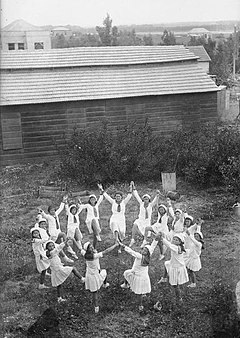Tu B'Av
| Tu B'Av | |
|---|---|
 Dancing girls on Tu B'Av | |
| Official name | Hebrew: ט״ו באב English: Fifteenth of Av |
| Type | Jewish |
| Observances | Tachanun and similar prayers are omitted from daily prayers |
| Date | 15th day of Av |
| 2023 date | Sunset, 1 August – nightfall, 2 August |
| 2024 date | Sunset, 18 August – nightfall, 19 August |
| 2025 date | Sunset, 8 August – nightfall, 9 August |
| 2026 date | Sunset, 28 July – nightfall, 29 July |
| Frequency | Annual |
Tu B'Av (
Etymology
Called Tu B'Av because of the sound of the two Hebrew letters whose combined numerical value corresponds to that of the date (15). The value 15 is obtained by combining the values of the letter Tet (9) and Vav (6), which, together, can be read as "tu," hence the name of the festival, Tu b'Av. The number 15 can also be obtained by combining the letters Yud (10) and Hey (5), but such combination would coincide with the first two letters of the Tetragrammaton, and thus are supplanted by the letters Tet and Vav to avoid using a name for the divine. Av is the name of the month in the Jewish calendar.
Historical significance
According to the
Various reasons for celebrating on Tu B'Av are cited by the Talmud and Talmudic
- While the Israelites wandered in the desert for forty years, female orphans without brothers could only marry within their tribe to prevent their father's inherited territory in the Land of Israel from passing on to other tribes, following the incident of the Daughters of Zelophehad. After the conquest and division of Canaan under Joshua, this ban was lifted on the fifteenth of Av and inter-tribal marriage was allowed.
- At the end of Israel's wandering in the wilderness, the last remnant of the generation of the sin of the spies, which had been forbidden from entering the Promised Land, found that they were not destined to die. For forty years, every Tisha B'av the Israelites made graves for themselves in which they slept expecting to be their last night; every year a proportion of them died. In the 40th year, the fifteen thousand who had remained from the first generation went to sleep in the graves and woke up the next day to their surprise. Thinking they made a mistake with the date, they kept sleeping in graves until they reached Tu B'Av and saw a full moon. Only then did they know they were going to enter the Land of Israel with the new generation.
- The Concubine of Gibeah (see Judges 19–21).
- Cutting of the wood for the main altar in the Temple was completed for the year. The holiday celebrated the wood-offering brought in the Temple (see Nehemiah 13:31). Josephus refers to it as the Feast of Xylophory ("Wood-bearing").[8]
- King ten tribes to once again have access to the Temple.
- The nights, traditionally the ideal time for Torah study, are lengthened again after the summer solstice, permitting more study.
- The Roman occupiers permitted burial of the victims of the massacre at Bar Kochba rebellion. Miraculously, the bodies had not decomposed, despite exposure to the elements for over a year.
Modern times
Tu B'Av is a day of joy that follows Tisha B'Av by six days and contrasts with the sadness of Tisha B'Av.[9] Tu B'Av does not have many established religious rituals associated with its celebration except that Tachanun is not said—either at mincha the day before or on the day itself—and a bride and groom traditionally do not fast if their wedding falls on Tu B'Av. These customs commemorate the happy events that occurred in the history of the Jewish People.[10]
In modern times, it has become a romantic Jewish holiday among secular Jews who mostly see it as the Jewish equivalent of
There is an initiative[
Pop culture
In Isaac Blum's 2022 novel, The Life and Crimes of Hoodie Rosen[16] the story begins during Tu B'Av.
References
- ^ a b "Tu Be'Av | The Jewish Agency". archive.jewishagency.org. 8 June 2005. Retrieved 6 August 2022.
- ^ Friedman, Yoav (4 August 2009). "Tu B'Av: Reclaiming old traditions". Ynetnews. Retrieved 7 August 2022.
- ^ Jewish Holidays: Tu B’Av
- ^ a b "Tu B'Av, the Jewish Day of Love". My Jewish Learning. Retrieved 6 August 2022.
- ^ "AB, FIFTEENTH DAY OF - JewishEncyclopedia.com". www.jewishencyclopedia.com. Retrieved 6 August 2022.
- ^ ט ו באב – המחולות והחגים, p.71-72
- ^ Babylonian Talmud 30b-31a, Rashi on these
- ^ Bellum Judaisum 2:17
- ISBN 978-1-4616-6243-3. Retrieved 7 August 2022.
- ^ "Tu B'Av - OU.ORG". 15 July 2009. Archived from the original on 15 July 2009. Retrieved 7 August 2022.
- ^ "Tu B'Av". Ynetnews. 23 May 2008. Retrieved 7 August 2022.
- ^ a b "Valentine's Day – When do Israelis celebrate love?". The Jerusalem Post | Jpost.com. Retrieved 7 August 2022.
- ^ "Celebrating love on Tu Be'av". The Jerusalem Post | Jpost.com. Retrieved 7 August 2022.
- ISBN 978-0-307-44086-0. Retrieved 7 August 2022.
- ^ "Pidyon Shvuyim + Free Tefillah by Yad L'Achim". tubavtogether.com.
- ^ "The Life and Crimes of Hoodie Rosen". 28 November 2022. Retrieved 7 July 2023.
